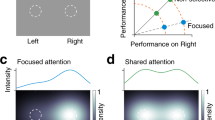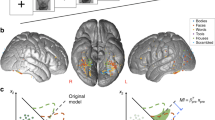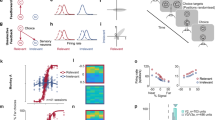Abstract
Neural activity in visual area V4 is enhanced when attention is directed into neuronal receptive fields. However, the source of this enhancement is unclear, as most physiological studies have manipulated attention by changing the absolute reward associated with a particular location as well as its value relative to other locations. We trained monkeys to discriminate the orientation of two stimuli presented simultaneously in different hemifields while we independently varied the reward magnitude associated with correct discrimination at each location. Behavioral measures of attention were controlled by the relative value of each location. By contrast, neurons in V4 were consistently modulated by absolute reward value, exhibiting increased activity, increased gamma-band power and decreased trial-to-trial variability whenever receptive field locations were associated with large rewards. These data challenge the notion that the perceptual benefits of spatial attention rely on increased signal-to-noise in V4. Instead, these benefits likely derive from downstream selection mechanisms.
This is a preview of subscription content, access via your institution
Access options
Subscribe to this journal
Receive 12 print issues and online access
$209.00 per year
only $17.42 per issue
Buy this article
- Purchase on Springer Link
- Instant access to full article PDF
Prices may be subject to local taxes which are calculated during checkout







Similar content being viewed by others
References
Carrasco, M. Visual attention: the past 25 years. Vision Res. 51, 1484–1525 (2011).
Awh, E., Belopolsky, A.V. & Theeuwes, J. Top-down versus bottom-up attentional control: a failed theoretical dichotomy. Trends Cogn. Sci. 16, 437–443 (2012).
Desimone, R. & Duncan, J. Neural mechanisms of selective visual attention. Annu. Rev. Neurosci. 18, 193–222 (1995).
Krauzlis, R.J., Bollimunta, A., Arcizet, F. & Wang, L. Attention as an effect not a cause. Trends Cogn. Sci. 18, 457–464 (2014).
Maunsell, J.H.R. & Cook, E.P. The role of attention in visual processing. Phil. Trans. R. Soc. Lond. B 357, 1063–1072 (2002).
Moran, J. & Desimone, R. Selective attention gates visual processing in the extrastriate cortex. Science 229, 782–784 (1985).
Fries, P., Reynolds, J.H., Rorie, A.E. & Desimone, R. Modulation of oscillatory neuronal synchronization by selective visual attention. Science 291, 1560–1563 (2001).
Gregoriou, G.G., Gotts, S.J., Zhou, H. & Desimone, R. High-frequency, long-range coupling between prefrontal and visual cortex during attention. Science 324, 1207–1210 (2009).
Womelsdorf, T., Fries, P., Mitra, P.P. & Desimone, R. Gamma-band synchronization in visual cortex predicts speed of change detection. Nature 439, 733–736 (2006).
Cohen, M.R. & Maunsell, J.H.R. Attention improves performance primarily by reducing interneuronal correlations. Nat. Neurosci. 12, 1594–1600 (2009).
Mitchell, J.F., Sundberg, K.A. & Reynolds, J.H. Differential attention-dependent response modulation across cell classes in macaque visual area V4. Neuron 55, 131–141 (2007).
Mitchell, J.F., Sundberg, K.A. & Reynolds, J.H. Spatial attention decorrelates intrinsic activity fluctuations in macaque area V4. Neuron 63, 879–888 (2009).
Maunsell, J.H.R. Neuronal representations of cognitive state: reward or attention? Trends Cogn. Sci. 8, 261–265 (2004).
Lauwereyns, J., Watanabe, K., Coe, B. & Hikosaka, O. A neural correlate of response bias in monkey caudate nucleus. Nature 418, 413–417 (2002).
Pastor-Bernier, A. & Cisek, P. Neural correlates of biased competition in premotor cortex. J. Neurosci. 31, 7083–7088 (2011).
Platt, M.L. & Glimcher, P.W. Neural correlates of decision variables in parietal cortex. Nature 400, 233–238 (1999).
Sugrue, L.P., Corrado, G.S. & Newsome, W.T. Matching behavior and the representation of value in the parietal cortex. Science 304, 1782–1787 (2004).
Peck, C.J., Lau, B. & Salzman, C.D. The primate amygdala combines information about space and value. Nat. Neurosci. 16, 340–348 (2013).
Staˇnis¸or, L., van der Togt, C., Pennartz, C.M. & Roelfsema, P.R. A unified selection signal for attention and reward in primary visual cortex. Proc. Natl. Acad. Sci. USA 110, 9136–9141 (2013).
Paton, J.J., Belova, M.A., Morrison, S.E. & Salzman, C.D. The primate amygdala represents the positive and negative value of visual stimuli during learning. Nature 439, 865–870 (2006).
Roesch, M.R. & Olson, C.R. Neuronal activity related to reward value and motivation in primate frontal cortex. Science 304, 307–310 (2004).
Varazzani, C., San-Galli, A., Gilardeau, S. & Bouret, S. Noradrenaline and dopamine neurons in the reward/effort trade-off: a direct electrophysiological comparison in behaving monkeys. J. Neurosci. 35, 7866–7877 (2015).
Serences, J.T. & Kastner, S. A multi-level account of selective attention. In The Oxford Handbook of Attention (Nobre, A.C. & Kastner, S.) 76–104 (Oxford University Press, 2014).
Pestilli, F., Carrasco, M., Heeger, D.J. & Gardner, J.L. Attentional enhancement via selection and pooling of early sensory responses in human visual cortex. Neuron 72, 832–846 (2011).
Mirpour, K. & Bisley, J.W. Dissociating activity in the lateral intraparietal area from value using a visual foraging task. Proc. Natl. Acad. Sci. USA 109, 10083–10088 (2012).
Chen, Y. & Seidemann, E. Attentional modulations related to spatial gating but not to allocation of limited resources in primate V1. Neuron 74, 557–566 (2012).
Itthipuripat, S., Ester, E.F., Deering, S. & Serences, J.T. Sensory gain outperforms efficient readout mechanisms in predicting attention-related improvements in behavior. J. Neurosci. 34, 13384–13398 (2014).
Zénon, A. & Krauzlis, R.J. Attention deficits without cortical neuronal deficits. Nature 489, 434–437 (2012).
Luo, T.Z. & Maunsell, J.H.R. Neuronal modulations in visual cortex are associated with only one of multiple components of attention. Neuron 86, 1182–1188 (2015).
Spitzer, H., Desimone, R. & Moran, J. Increased attention enhances both behavioral and neuronal performance. Science 240, 338–340 (1988).
Cohen, M.R. & Maunsell, J.H.R. A neuronal population measure of attention predicts behavioral performance on individual trials. J. Neurosci. 30, 15241–15253 (2010).
McAdams, C.J. & Maunsell, J.H. Effects of attention on orientation-tuning functions of single neurons in macaque cortical area V4. J. Neurosci. 19, 431–441 (1999).
Reynolds, J.H., Pasternak, T. & Desimone, R. Attention increases sensitivity of V4 neurons. Neuron 26, 703–714 (2000).
Williford, T. & Maunsell, J. Effects of spatial attention on contrast response functions in macaque area V4. J. Neurophysiol. 96, 40–54 (2006).
Thiele, A., Pooresmaeili, A., Delicato, L.S., Herrero, J.L. & Roelfsema, P.R. Additive effects of attention and stimulus contrast in primary visual cortex. Cereb. Cortex 19, 2970–2981 (2009).
Sanayei, M., Herrero, J.L., Distler, C. & Thiele, A. Attention and normalization circuits in macaque V1. Eur. J. Neurosci. 41, 949–964 (2015).
McGinley, M.J. et al. Waking state: rapid variations modulate neural and behavioral responses. Neuron 87, 1143–1161 (2015).
Harris, K.D. & Thiele, A. Cortical state and attention. Nat. Rev. Neurosci. 12, 509–523 (2011).
Reimer, J. et al. Pupil fluctuations track fast switching of cortical states during quiet wakefulness. Neuron 84, 355–362 (2014).
Boudreau, C.E., Williford, T.H. & Maunsell, J.H.R. Effects of task difficulty and target likelihood in area V4 of macaque monkeys. J. Neurophysiol. 96, 2377–2387 (2006).
Ruff, D.A. & Cohen, M.R. Global cognitive factors modulate correlated response variability between V4 neurons. J. Neurosci. 34, 16408–16416 (2014).
Padoa-Schioppa, C. & Assad, J.A. Neurons in the orbitofrontal cortex encode economic value. Nature 441, 223–226 (2006).
Leon, M.I. & Shadlen, M.N. Effect of expected reward magnitude on the response of neurons in the dorsolateral prefrontal cortex of the macaque. Neuron 24, 415–425 (1999).
McCoy, A.N., Crowley, J.C., Haghighian, G., Dean, H.L. & Platt, M.L. Saccade reward signals in posterior cingulate cortex. Neuron 40, 1031–1040 (2003).
Kim, H.F. & Hikosaka, O. Distinct basal ganglia circuits controlling behaviors guided by flexible and stable values. Neuron 79, 1001–1010 (2013).
Peck, C.J. & Salzman, C.D. The amygdala and basal forebrain as a pathway for motivationally guided attention. J. Neurosci. 34, 13757–13767 (2014).
Reynolds, J.H. & Heeger, D.J. The normalization model of attention. Neuron 61, 168–185 (2009).
Falkner, A.L., Krishna, B.S. & Goldberg, M.E. Surround suppression sharpens the priority map in the lateral intraparietal area. J. Neurosci. 30, 12787–12797 (2010).
Louie, K., Grattan, L.E. & Glimcher, P.W. Reward value-based gain control: divisive normalization in parietal cortex. J. Neurosci. 31, 10627–10639 (2011).
Moore, T., Armstrong, K.M. & Fallah, M. Visuomotor origins of covert spatial attention. Neuron 40, 671–683 (2003).
Ghose, G.M. & Maunsell, J. Attentional modulation in visual cortex depends on task timing. Nature 419, 616–620 (2002).
Mitra, P. & Bokil, H. Observed Brain Dynamics (Oxford University Press, 2007).
Churchland, M.M. et al. Stimulus onset quenches neural variability: a widespread cortical phenomenon. Nat. Neurosci. 13, 369–378 (2010).
Ringach, D.L., Hawken, M.J. & Shapley, R. Dynamics of orientation tuning in macaque primary visual cortex. Nature 387, 281–284 (1997).
Acknowledgements
We thank S. Bouret, E. Bromberg-Martin, V. Ciaramitaro, K. Louie and F. Pestilli for helpful comments on an earlier version of the manuscript, S. Dashnaw for MRI support, G. Asfaw for veterinary support, and K. Marmon for technical support. This research was supported by grants to C.D.S. from the US National Institute of Mental Health (NIMH) (R01 MH082017) and by a core grant from the US National Eye Institute (NEI) (P30-EY19007) to Columbia University. B.L. received support from the NIMH (T32-MH015144) and the Helen Hay Whitney Foundation. J.K.B. received support from the NEI (T32-EY013933) and the Columbia University Medical Scientist Training Program.
Author information
Authors and Affiliations
Contributions
B.L. designed the experiment. J.K.B. and B.L. collected the data and wrote the manuscript. J.K.B. analyzed the data with assistance from B.L. C.D.S. supervised and provided input about all aspects of the project and edited the manuscript.
Ethics declarations
Competing interests
The authors declare no competing financial interests.
Integrated supplementary information
Supplementary Figure 1 Psychometric functions.
Proportion correct as a function of task difficulty, shown separately for Monkey 1 (a) and Monkey 2 (b). Labels on abscissa indicate orientation bin edges. Error bars indicate +/− 1 s.e.m.
Supplementary Figure 2 Behavioral effects were consistent across monkeys.
Behavioral data are presented as function of relative target value or average trial value, from all trials completed during recording sessions in Monkey 1 (a-d, 5,174 LS; 5,230 LL; 5,312 SL; and 5,226 SS trials) and Monkey 2 (e-h, 6,881 LS; 6,965 LL; 7,018 SL; and 6,953 SS trials). Error bars indicate +/− 1 s.e.m. Overlapping points are slightly offset for visualization. (a,b) Performance and reaction time track relative target value in M1. Percent correct was highest in LS (CMH, p<10−10 for all comparisons), and lowest in SL (CMH, p<10−10 for all comparisons). Reaction times were fastest in LS (WRS, p<10−10 for all comparisons), and slowest in SL (WRS, p<10−10 for all comparisons). Performance was slightly higher (CMH, p = .0402) and reaction times slightly faster (WRS, p<10−4) in LL compared to SS trials. (c,d) Pupil diameter and abort rate track average trial value in M1. Pupils were most dilated in LL (WRS, p<10−10 for all comparisons) and least dilated in SS (WRS, p<10−10 for all comparisons). Abort rate was highest in SS (CMH, p<10−10 for all comparisons) and lowest in LL (CMH, p<10−6 for all comparisons). (e,f) Performance and reaction time track relative target value in M2. Percent correct was highest in LS (CMH, p<10−3 for all comparisons), and lowest in SL (CMH, p<10−10 for all comparisons). Reaction times were fastest in LS (WRS, p<10−10 for all comparisons), and slowest in SL (WRS, p<10−10 for all comparisons). Performance was slightly higher (CMH, p=.0066) and reaction times faster (WRS, p<10−10) in LL compared to SS trials. (g,h) Pupil diameter and abort rate track average trial value in M2. Pupils were most dilated in LL (WRS, p<10−10 for all comparisons) and least dilated in SS (WRS, p<10−10 for all comparisons). Abort rate was highest in SS (CMH, p<10−5 for all comparisons), and did not significantly differ between the other three conditions (CMH, p>0.1 for all comparisons).
Supplementary Figure 3 Behavioral effects were consistent across locations.
Behavioral data are presented as function of relative target value, from all trials completed during recording sessions in Monkey 1 (a-d) and Monkey 2 (e-h). Behavioral data are shown separately for targets contralateral (a,b,e,f) and ipsilateral (c,d,g,h) to the recorded brain area. Error bars indicate +/− 1 s.e.m. Overlapping points are slightly offset for visualization. (a,c) Performance tracks relative target value at each location in M1. At each location, performance was highest in LS (CMH, p<10−4) and lowest in SL (CMH, p<10−10). (b,d) Reaction times track relative target value at each location in M1. At each location, reaction times were fastest in LS (WRS, p<10−10), and slowest in SL (WRS, p<10−10) (e) Performance tracks relative target value at the contralateral location in M2. Performance was highest in LS (CMH, p<10−3) and lowest in SL (CMH, p<10−10). (g) At the ipsilateral location, performance was highest in LS (79.24%), but not significantly higher than either LL (77.98%; CMH, p>0.05) or SS conditions (77.87%; CMH, p>0.05). Performance at the ipsilateral location was lowest in SL (64.05%, CMH, p<10−10). (f,h) Reaction times track relative target value at each location in M2. At each location, reaction times were fastest in LS (WRS, p<10−10) and slowest in SL (WRS, p<10−10).
Supplementary Figure 4 Neural and behavioral effects across the population were similar in each monkey
Joint and marginal distributions of regression coefficients for Monkey 1 (a-c, n = 46 behavioral sessions, n = 106 recorded units) and Monkey 2 (d-f, n = 33 behavioral sessions, n = 84 recorded units). Symbol style denotes significance for individual sessions/units. (a) Reaction times reflect relative target value in all M1 sessions. Associating the larger reward with the target location decreased reaction times (WSR, p<10−8), whereas large rewards at distracter locations increased reaction times (WSR, p<10−8). (b) Pupil diameter reflects average trial value in M1 sessions. Associating the large reward with either the target (WSR, p<10−7) or distracter (WSR, p<10−7) increased pupil diameters. (c) Neuronal modulation reflects RF value in M1. Large rewards at the RF location were associated with increased firing rates (mean = +3.55 spikes/s; WSR, p<10−8). Large rewards opposite the RF were not associated with a significant change in firing rate (mean = −0.301 spikes/s; WSR, p = 0.45). (d) Reaction times reflect relative target value in all M2 sessions. Associating the larger reward with the target location decreased reaction times (WSR, p<10−6), whereas large rewards at distracter locations increased reaction times (WSR, p<10−6). (e) Pupil diameter reflects average trial value in all M1 sessions. Associating the large reward with either the target (WSR, p<10−6) or distracter (WSR, p<10−6) increased pupil diameters. (f) Neuronal modulation reflects RF value in M1. Large rewards at the RF location were associated with increased firing rates (mean = +4.69 spikes/s; WSR, p<10−10). Large rewards opposite the RF were not associated with a significant change in firing rate (mean= +0.276 spikes/s; WSR, p = 0.32).
Supplementary Figure 5 Relative RF value and average trial value increase gamma band power in both monkeys.
Raw (a,b) and normalized (c,d) power spectra for each monkey. Power spectra from the reference epoch used for normalization are indicated by the dotted line (a,b). In Monkey 1 (a,c, n = 40 sites), increases in relative RF value and average trial value both increased power in the gamma band (40-80hz; WSR, p<10−3). In Monkey 2 (b,d, n = 29 sites), increases in relative RF value and average trial value both increased power in the gamma band (40-80hz; WSR, p<10−4).
Supplementary Figure 6 Pupil diameters diverge after reward cue presentation.
Z-scored pupil diameters are aligned on two events in the trial. On the left, pupil values are aligned to acquisition of fixation. On the right, pupil values are aligned to onset of discriminanda. In all traces, line thickness exceeds +/− 1 s.e.m. After reward cue presentation (shaded box at left) and through streaming Gabor stimulus (shaded box at right), pupil diameters reflect average trial value. (n = 48,103)
Supplementary Figure 7 Regression coefficients for expanded model.
Symbol style denotes significance for individual sessions/units (n = 190). (a) Large rewards at the RF location were associated with increased firing rates (mean β1 = +3.678 spikes/sec). (b) Large rewards opposite the RF were associated with small increases in firing rate (mean β2= +0.397 spikes/sec), inconsistent with relative value modulation (c) Increased reaction times were associated with small decreases in firing rate (mean β3 = −0.350 spikes/sec). (d) Increased pupil diameters were associated with small decreases in firing rate (mean β4= −0.350 spikes/sec).
Supplementary Figure 8 Procedure for constructing orientation-tuning functions.
(a) Spike density functions (SDF) for an example unit. Responses to individual 20ms Gabor presentations within the stimulus stream were sorted by orientation, aligned on presentation onset, and averaged to generate spike density functions. (b) To determine a unit-specific spike count window, we computed the effect size (η2) of Gabor orientation on firing rate in a sliding window (5 ms wide, 1 ms steps). Effect sizes, as well as correlation of SDFs across time, were used to define the window, denoted by the shaded line. (c,d) Spike counts were compiled into orientation tuning functions and fit with Gaussian functions. Error bars indicate +/− 1 s.e.m. Dashed lines indicate mean responses for each condition, averaged across orientation.
Supplementary information
Supplementary Text and Figures
Supplementary Figures 1–8 (PDF 1030 kb)
Rights and permissions
About this article
Cite this article
Baruni, J., Lau, B. & Salzman, C. Reward expectation differentially modulates attentional behavior and activity in visual area V4. Nat Neurosci 18, 1656–1663 (2015). https://doi.org/10.1038/nn.4141
Received:
Accepted:
Published:
Issue Date:
DOI: https://doi.org/10.1038/nn.4141
This article is cited by
-
Single-trial visually evoked potentials predict both individual choice and market outcomes
Scientific Reports (2023)
-
Prefrontal cortex interactions with the amygdala in primates
Neuropsychopharmacology (2022)
-
Interactions between ventrolateral prefrontal and anterior cingulate cortex during learning and behavioural change
Neuropsychopharmacology (2022)
-
Single trial neuronal activity dynamics of attentional intensity in monkey visual area V4
Nature Communications (2021)
-
Simultaneous multi-area recordings suggest that attention improves performance by reshaping stimulus representations
Nature Neuroscience (2019)



